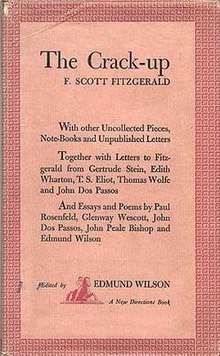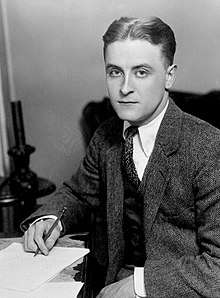The Crack-Up
The Crack-Up (1945) is a collection of essays by American author F. Scott Fitzgerald. It includes previously unpublished letters and notes, along with the three essays Fitzgerald originally wrote for Esquire magazine, which were first published in 1936. After Fitzgerald's death in 1940, Edmund Wilson compiled and edited this anthology, first published by New Directions in 1945.
 First edition cover | |
| Author | F. Scott Fitzgerald |
|---|---|
| Country | United States |
| Language | English |
| Genre | Essays, letters and notes. |
| Publisher | New Directions |
Publication date | 1945 |
| Media type | Print (Hardback & Paperback) |
| Pages | 347 pp |
The main essay starts "Of course all life is a process of breaking down ...."[1] which gives something of the tone of the piece.
Essays
- "The Crack-Up" (originally Esquire magazine, February 1936)
- "Pasting It Together" (originally Esquire magazine, March 1936)
- "Handle with Care" (originally Esquire magazine, April 1936)
- collected together under the title The Crack-Up in the book
It also includes other essays by Fitzgerald and positive evaluations of his work by Glenway Wescott, John Dos Passos, and John Peale Bishop, plus 1925 letters from Gertrude Stein, T. S. Eliot, and Edith Wharton, praising Fitzgerald's novel The Great Gatsby.
Famous quotes
At the beginning of The Crack-Up Fitzgerald makes this widely quoted general observation:—
the test of a first-rate intelligence is the ability to hold two opposed ideas in the mind at the same time, and still retain the ability to function.
— F. Scott Fitzgerald
As an example of this "truth," he cites the ability to see that things are hopeless and yet be determined to make them otherwise. In modern decision theory, the quote has been used by some to explain the bias shown in many experiments, where subjects gather information to justify a preconceived notion. These experiments suggest that the mental ability described by Fitzgerald (being able to see both sides of an argument) is rarer than many assume.
Reaction
The essays when originally written were poorly received and many reviewers were openly critical, particularly of the personal revelations. Time has been somewhat kinder to them and the collection is an insight into the mind of the writer during this low period in his life.
The essays stand today as a compelling psychological portrait and an illustration of an important Fitzgerald theme
— Bitonti [2]
The philosopher Gilles Deleuze adopted the term crack-up from Fitzgerald to refer to his interpretation of the Freudian death instinct[3].
In popular culture
The title of the 2017 Fleet Foxes album Crack-Up was inspired by these essays.[4]
References
- Fitzgerald, "The Crack-Up", p.1
- Bitonti, paragraph 1
- Korine,"A Crack-Up at the Race Riots"
- Fleet Foxes - Robin Pecknold Interview with Zach Cowie
- Fitzgerald, F. Scott (1945). The Crack-Up (1st ed.). New Directions.
- Bitonti, Tracy Simmons (12 May 2005). "The Crack-Up". Facts about Fitzgerald. Archived from the original on 12 May 2008. Retrieved 15 June 2007.
- Korine, Harmony. "A Crack-Up at the Race Riots". Rain Taxi. Retrieved 18 January 2018.
External links
- The Crack-Up By F. Scott Fitzgerald, Esquire. Originally published in Esquire's February, March, and April 1936 issues.
